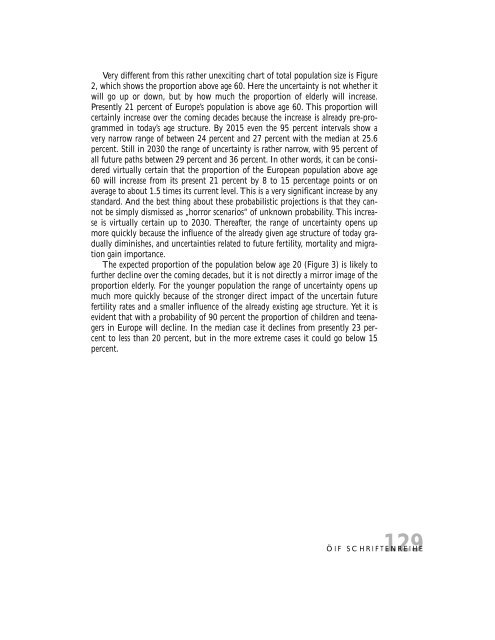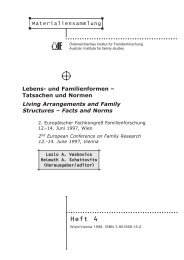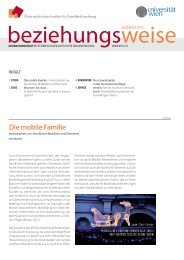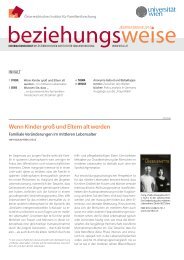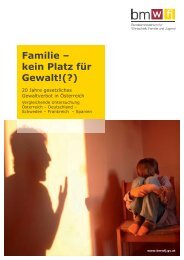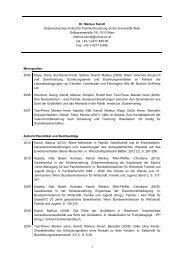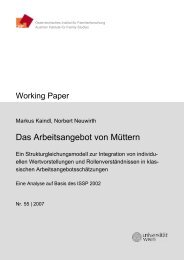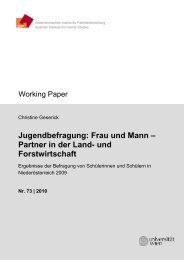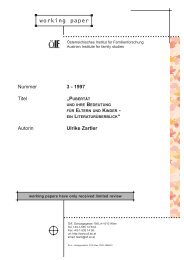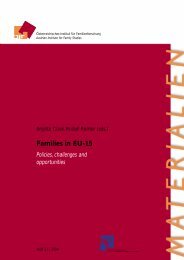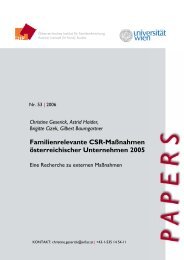Kompendium der Familienforschung in Ãsterreich, Schriftenreihe Nr. 7
Kompendium der Familienforschung in Ãsterreich, Schriftenreihe Nr. 7
Kompendium der Familienforschung in Ãsterreich, Schriftenreihe Nr. 7
Erfolgreiche ePaper selbst erstellen
Machen Sie aus Ihren PDF Publikationen ein blätterbares Flipbook mit unserer einzigartigen Google optimierten e-Paper Software.
Very different from this rather unexcit<strong>in</strong>g chart of total population size is Figure<br />
2, which shows the proportion above age 60. Here the uncerta<strong>in</strong>ty is not whether it<br />
will go up or down, but by how much the proportion of el<strong>der</strong>ly will <strong>in</strong>crease.<br />
Presently 21 percent of Europe’s population is above age 60. This proportion will<br />
certa<strong>in</strong>ly <strong>in</strong>crease over the com<strong>in</strong>g decades because the <strong>in</strong>crease is already pre-programmed<br />
<strong>in</strong> today’s age structure. By 2015 even the 95 percent <strong>in</strong>tervals show a<br />
very narrow range of between 24 percent and 27 percent with the median at 25.6<br />
percent. Still <strong>in</strong> 2030 the range of uncerta<strong>in</strong>ty is rather narrow, with 95 percent of<br />
all future paths between 29 percent and 36 percent. In other words, it can be consi<strong>der</strong>ed<br />
virtually certa<strong>in</strong> that the proportion of the European population above age<br />
60 will <strong>in</strong>crease from its present 21 percent by 8 to 15 percentage po<strong>in</strong>ts or on<br />
average to about 1.5 times its current level. This is a very significant <strong>in</strong>crease by any<br />
standard. And the best th<strong>in</strong>g about these probabilistic projections is that they cannot<br />
be simply dismissed as „horror scenarios“ of unknown probability. This <strong>in</strong>crease<br />
is virtually certa<strong>in</strong> up to 2030. Thereafter, the range of uncerta<strong>in</strong>ty opens up<br />
more quickly because the <strong>in</strong>fluence of the already given age structure of today gradually<br />
dim<strong>in</strong>ishes, and uncerta<strong>in</strong>ties related to future fertility, mortality and migration<br />
ga<strong>in</strong> importance.<br />
The expected proportion of the population below age 20 (Figure 3) is likely to<br />
further decl<strong>in</strong>e over the com<strong>in</strong>g decades, but it is not directly a mirror image of the<br />
proportion el<strong>der</strong>ly. For the younger population the range of uncerta<strong>in</strong>ty opens up<br />
much more quickly because of the stronger direct impact of the uncerta<strong>in</strong> future<br />
fertility rates and a smaller <strong>in</strong>fluence of the already exist<strong>in</strong>g age structure. Yet it is<br />
evident that with a probability of 90 percent the proportion of children and teenagers<br />
<strong>in</strong> Europe will decl<strong>in</strong>e. In the median case it decl<strong>in</strong>es from presently 23 percent<br />
to less than 20 percent, but <strong>in</strong> the more extreme cases it could go below 15<br />
percent.<br />
129<br />
ÖIF SCHRIFTENREIHE


